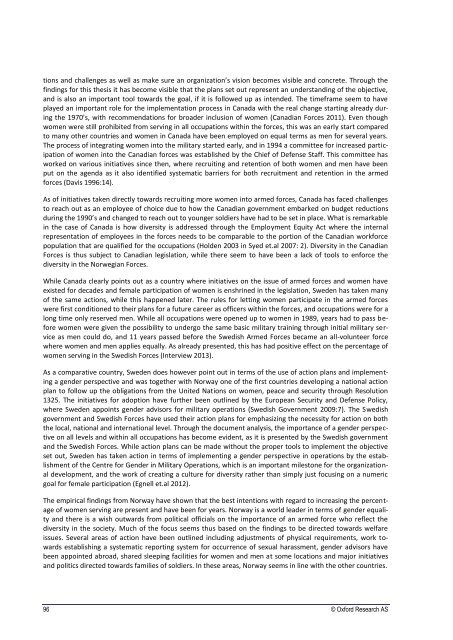Create successful ePaper yourself
Turn your PDF publications into a flip-book with our unique Google optimized e-Paper software.
tions and challenges as well as make sure an organization’s vision becomes visible and concrete. Through the<br />
findings for this thesis it has become visible that the plans set out represent an understanding of the objective,<br />
and is also an important tool towards the goal, if it is followed up as intended. The timeframe seem to have<br />
played an important role for the implementation process in Canada with the real change starting already during<br />
the 1970’s, with recommendations for broader inclusion of women (Canadian Forces 2011). Even though<br />
women were still prohibited from serving in all occupations within the forces, this was an early start compared<br />
to many other countries and women in Canada have been employed on equal terms as men for several years.<br />
The process of integrating women into the military started early, and in 1994 a committee for increased participation<br />
of women into the Canadian forces was established by the Chief of Defense Staff. This committee has<br />
worked on various initiatives since then, where recruiting and retention of both women and men have been<br />
put on the agenda as it also identified systematic barriers for both recruitment and retention in the armed<br />
forces (Davis 1996:14).<br />
As of initiatives taken directly towards recruiting more women into armed forces, Canada has faced challenges<br />
to reach out as an employee of choice due to how the Canadian government embarked on budget reductions<br />
during the 1990’s and changed to reach out to younger soldiers have had to be set in place. What is remarkable<br />
in the case of Canada is how diversity is addressed through the Employment Equity Act where the internal<br />
representation of employees in the forces needs to be comparable to the portion of the Canadian workforce<br />
population that are qualified for the occupations (Holden 2003 in Syed et.al 2007: 2). Diversity in the Canadian<br />
Forces is thus subject to Canadian legislation, while there seem to have been a lack of tools to enforce the<br />
diversity in the Norwegian Forces.<br />
While Canada clearly points out as a country where initiatives on the issue of armed forces and women have<br />
existed for decades and female participation of women is enshrined in the legislation, Sweden has taken many<br />
of the same actions, while this happened later. The rules for letting women participate in the armed forces<br />
were first conditioned to their plans for a future career as officers within the forces, and occupations were for a<br />
long time only reserved men. While all occupations were opened up to women in 1989, years had to pass before<br />
women were given the possibility to undergo the same basic military training through initial military service<br />
as men could do, and 11 years passed before the Swedish Armed Forces became an all-volunteer force<br />
where women and men applies equally. As already presented, this has had positive effect on the percentage of<br />
women serving in the Swedish Forces (Interview 2013).<br />
As a comparative country, Sweden does however point out in terms of the use of action plans and implementing<br />
a gender perspective and was together with Norway one of the first countries developing a national action<br />
plan to follow up the obligations from the United Nations on women, peace and security through Resolution<br />
1325. The initiatives for adoption have further been outlined by the European Security and Defense Policy,<br />
where Sweden appoints gender advisors for military operations (Swedish Government 2009:7). The Swedish<br />
government and Swedish Forces have used their action plans for emphasizing the necessity for action on both<br />
the local, national and international level. Through the document analysis, the importance of a gender perspective<br />
on all levels and within all occupations has become evident, as it is presented by the Swedish government<br />
and the Swedish Forces. While action plans can be made without the proper tools to implement the objective<br />
set out, Sweden has taken action in terms of implementing a gender perspective in operations by the establishment<br />
of the Centre for Gender in Military Operations, which is an important milestone for the organizational<br />
development, and the work of creating a culture for diversity rather than simply just focusing on a numeric<br />
goal for female participation (Egnell et.al 2012).<br />
The empirical findings from Norway have shown that the best intentions with regard to increasing the percentage<br />
of women serving are present and have been for years. Norway is a world leader in terms of gender equality<br />
and there is a wish outwards from political officials on the importance of an armed force who reflect the<br />
diversity in the society. Much of the focus seems thus based on the findings to be directed towards welfare<br />
issues. Several areas of action have been outlined including adjustments of physical requirements, work towards<br />
establishing a systematic reporting system for occurrence of sexual harassment, gender advisors have<br />
been appointed abroad, shared sleeping facilities for women and men at some locations and major initiatives<br />
and politics directed towards families of soldiers. In these areas, Norway seems in line with the other countries.<br />
96 © Oxford Research AS



